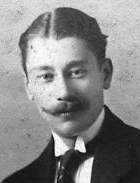Léo Taxil

Marie Joseph Gabriel Antoine Jogand-Pagès, better known by the pen name Léo Taxil (French pronunciation: [leo taksil]; March 21, 1854–March 31, 1907), was a French writer and journalist who became known for his strong anti-Catholic and anti-clerical views. He is also known for the Taxil hoax, a spurious exposé of Freemasonry and the Roman Catholic Church's opposition to it.
Early life
Marie Joseph Gabriel Antoine Jogand-Pagès was born in Marseille and at the age of five was placed into a Jesuit seminary. After spending his childhood years in the seminary he became disillusioned with the Catholic faith and began to see the religious ideology as socially harmful.
La Bible amusante
Taxil first became known for writing anti-Catholic books, notably La Bible amusante (The Amusing Bible) and La Vie de Jesus (The Life of Jesus) in which Taxil satirically pointed out what he considered to be inconsistencies, errors, and false beliefs presented in these religious works. In his other books Les Debauches d'un confesseur (with Karl Milo), Les Pornographes sacrés: la confession et les confesseurs, and Les Maîtresses du Pape, Taxil portrays leaders of the Catholic Church as hedonistic creatures exploring their fetishes in the manner of the Marquis de Sade. In 1879 he was tried at the Seine Assizes for writing a pamphlet A Bas la Calotte ("Down with the Cloth"), which was accused of insulting a religion recognized by the state, but he was acquitted.
The Taxil hoax
In 1885 he professed conversion to Catholicism, was solemnly received into the church, and renounced his earlier works. In the 1890s he wrote a series of pamphlets and books denouncing Freemasonry,[1] charging their lodges with worshiping the devil and alleging that Diana Vaughan had written for him her confessions of the Satanic "Palladist" cult. That book had great sales among Catholics, although Diana Vaughan never appeared in public. In 1892 Taxil also began to publish a paper La France chrétienne anti-maçonnique. In 1887 he had an audience with Pope Leo XIII, who rebuked the bishop of Charleston for denouncing the anti-Masonic confessions as a fraud and in 1896 sent his blessing to an anti-Masonic Congress in Trent.[citation needed]
Doubts about Vaughan's veracity and even her existence began to grow, and finally Taxil promised to produce her at a lecture to be delivered by him on 19 April 1897. To the amazement of the audience (which included a number of priests), he announced that Diana was one of a series of hoaxes.[1] He had begun, he said, by persuading the commandant of Marseille that the harbour was infested with sharks, and a ship was sent to destroy them. Next he invented an underwater city in Lake Geneva, drawing tourists and archaeologists to the spot. He thanked the bishops and Catholic newspapers for facilitating his crowning hoax, namely his conversion, which had exposed the anti-Masonic fanaticism of many Catholics. Diana Vaughan was revealed to be a simple typist in his employ, who laughingly allowed her name to be used by him.[citation needed]
The audience received these revelations with indignation and contempt, and Taxil was mobbed on leaving the hall so that policemen had to escort him to a neighbouring café. He then moved away from Paris. He died in Sceaux in 1907.[citation needed]
Books
- La Vie de Jesus (The Amusing Gospel)
- La Bible amusante (The Amusing Bible)
- Les Débauches d'un confesseur
- Les Pornographes sacrés: la confession et les confesseurs
- Les Maîtresses du Pape(The Pope's mistresses)
Notes
References
- Satan Franc-Maçon: la mystification de Léo Taxil, 1964.
See also
- The Prague Cemetery, novel by Umberto Eco, 2010
External links
| Wikimedia Commons has media related to Category:Léo Taxil. |
- A.E. Waite, Devil-Worship in France With Diana Vaughan and the Question of Modern Palladism complete e-text of Waite's debunking of Taxil.
|